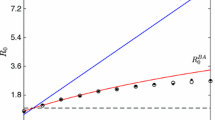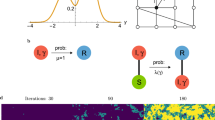Abstract
We extend a recent study of susceptible-infected-removed epidemic processes with long range infection (referred to as I in the following) from 1-dimensional lattices to lattices in two dimensions. As in I we use hashing to simulate very large lattices for which finite size effects can be neglected, in spite of the assumed power law p(x)∼|x|−σ−2 for the probability that a site can infect another site a distance vector x apart. As in I we present detailed results for the critical case, for the supercritical case with σ=2, and for the supercritical case with 0<σ<2. For the latter we verify the stretched exponential growth of the infected cluster with time predicted by M. Biskup. For σ=2 we find generic power laws with σ-dependent exponents in the supercritical phase, but no Kosterlitz-Thouless (KT) like critical point as in 1-d. Instead of diverging exponentially with the distance from the critical point, the correlation length increases with an inverse power, as in an ordinary critical point. Finally we study the dependence of the critical exponents on σ in the regime 0<σ<2, and compare with field theoretic predictions. In particular we discuss in detail whether the critical behavior for σ slightly less than 2 is in the short range universality class, as conjectured recently by F. Linder et al. As in I we also consider a modified version of the model where only some of the contacts are long range, the others being between nearest neighbors. If the number of the latter reaches the percolation threshold, the critical behavior is changed but the supercritical behavior stays qualitatively the same.





























Similar content being viewed by others
Notes
Lattices with 264 sites are of course also finite, but they are strictly equivalent to infinite ones, if growing clusters never form fake loops which would be absent on infinite lattices. In that sense, all simulations except those in Sect. 5.4 were effectively done on infinite lattices.
Alternatively, we could have plotted these data against 1/L 1/ν, and looked for straight lines. Unfortunately, this would give ν≈2.0, if we keep the value D f =1.707, or it would give D f ≈1.69, if we insist on ν=4/3 or ν=1.42 as suggested by Fig. 28. Both are incompatible with standard percolation and with the scenario proposed in this paper. We take this as a further indication that—even if finite size scaling works well in principle—there are large corrections to scaling.
Notice that one cannot use the huge corrections to scaling seen e.g. in Fig. 25 to argue away the problem. If there were no singularity at σ=2, there would be no reason for any large corrections to scaling.
References
Newman, M.E.J.: Phys. Rev. E 66, 016128 (2002)
Janssen, H.-K., Müller, M., Stenull, O.: Phys. Rev. E 70, 026114 (2004)
Bizhani, G., Paczuski, M., Grassberger, P.: Phys. Rev. E 86, 011128 (2012)
Mollison, D.: J. R. Stat. Soc. B 30, 283 (1977)
Grassberger, P.: Math. Biosci. 63, 157 (1983)
Grassberger, P.: Spreading of epidemic processes leading to fractal structures. In: Pietronero, L., Tosatti, E. (eds.) Fractals in Physics, p. 273. Elsevier, Amsterdam (1986)
Janssen, H.-K., Oerding, K., van Wijland, F., Hilhorst, H.J.: Eur. Phys. J. B 7, 137 (1999)
Linder, F., Tran-Gia, J., Dahmen, S.R., Hinrichsen, H.: J. Phys. A 41, 185005 (2008)
Fisher, M.E., Ma, S., Nickel, B.G.: Phys. Rev. Lett. 29, 917 (1972)
Sak, J.: Phys. Rev. B 8, 281 (1973)
Yamazaki, Y.: Phys. Lett. 61A, 207 (1977)
Gusmão, M.A., Theumann, W.K.: Phys. Rev. B 28, 6545 (1983)
Honkonen, J., Nalimov, M.Y.: J. Phys. A 22, 751 (1989)
Luijten, E., Messingfeld, H.: Phys. Rev. Lett. 86, 5305 (2001)
Luijten, E., Blöte, W.J.: Phys. Rev. Lett. 89, 025703 (2002)
Ruelle, D.: Statistical Mechanics: Rigorous Results. Benjamin, Elmsford (1969)
Dyson, F.J.: Commun. Math. Phys. 91, 212 (1969)
Anderson, P.W., Yuval, G., Hamann, D.R.: Phys. Rev. B 1, 4464 (1970)
Thouless, D.J.: Phys. Rev. 187, 732 (1969)
Cardy, J.: J. Phys. A 14, 1407 (1981)
Schulman, L.S.: J. Phys. A 16, L639 (1983)
Aizenman, M., Newman, C.M.: Commun. Math. Phys. 107, 611 (1986)
Aizenman, M., Chayes, J.T., Chayes, L., Newman, C.M.: J. Stat. Phys. 50, 1 (1988)
Grassberger, P.: J. Stat. Mech. (2013)
Kleinberg, J.: In: Proceedings of the Thirty-Second Annual ACM Symposium on Theory of Computing, STOC ’00, pp. 163–170. ACM, New York (2000)
Brockmann, D., Hufnagel, L., Geisel, T.: Nature 439, 462 (2006)
Brockmann, D., Hufnagel, L.: Phys. Rev. Lett. 98, 178301 (2007)
Barthélemy, M.: Phys. Rep. 499, 1 (2011)
Biskup, M.: Ann. Probab. 19, 2938 (2004)
Benjamini, I., Berger, N.: Random Struct. Algorithms 19, 102 (2001)
Berger, N.: arXiv:math/0409021 (2004)
Coppersmith, D., Gamarnik, D., Sviridenko, M.: Random Struct. Algorithms 21, 1 (2002)
Biskup, M.: arXiv:math/0406379v2 (2009)
Mancinelli, R., Vergni, D., Vulpiani, A.: Europhys. Lett. 60, 532 (2002)
del Castillo-Negrete, D., Carreras, B.A., Lynch, V.E.: Phys. Rev. Lett. 91, 018302 (2003)
Sen, P., Chakrabarti, B.: J. Phys. A 34, 7749 (2001)
Sen, P., Banerjee, K., Biswas, T.: Phys. Rev. E 66, 037102 (2001)
Moukarzel, C.F., de Menzes, M.Argollo: Phys. Rev. E 65, 056709 (2002)
Goswami, S., Biswas, S., Sen, P.: Physica A 390, 972 (2011)
Emmerich, T., Bunde, A., Havlin, S., Guanlian, L., Daqing, L.: arXiv:1206.5710 (2012)
Grassberger, P.: J. Phys. A, Math. Gen. 25, 5475 (1992)
Lorenz, C.D., Ziff, R.M.: Phys. Rev. E 57, 230 (1998)
Grassberger, P.: Phys. Rev. E 67, 036101 (2003)
Grassberger, P.: J. Stat. Mech. 2006, P01004 (2006)
Kosmidis, K., Havlin, S., Bunde, A.: Europhys. Lett. 82, 48005 (2008)
Daqing, L., Kosmidis, K., Bunde, A., Havlin, S.: Nat. Phys. 7, 481 (2011)
Acknowledgements
For very helpful discussions I want to thank Aicko Schumann and Deepak Dhar. I also want to thank the latter for the kind hospitality at the Tata Institute of Fundamental Research in Mumbai, where part of this work was done. The work was begun at the Complexity Science Group at the Universality of Calgary. Finally my thanks go to Haye Hinrichsen and Hans-Karl Janssen for illuminating correspondence.
Author information
Authors and Affiliations
Corresponding author
Rights and permissions
About this article
Cite this article
Grassberger, P. Two-Dimensional SIR Epidemics with Long Range Infection. J Stat Phys 153, 289–311 (2013). https://doi.org/10.1007/s10955-013-0824-7
Received:
Accepted:
Published:
Issue Date:
DOI: https://doi.org/10.1007/s10955-013-0824-7




